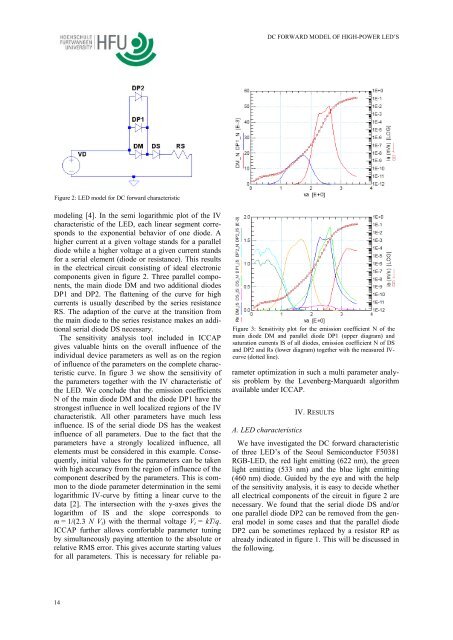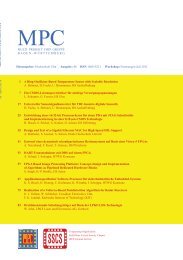Workshopband als PDF - Mpc.belwue.de
Workshopband als PDF - Mpc.belwue.de
Workshopband als PDF - Mpc.belwue.de
Sie wollen auch ein ePaper? Erhöhen Sie die Reichweite Ihrer Titel.
YUMPU macht aus Druck-PDFs automatisch weboptimierte ePaper, die Google liebt.
Figure 2: LED mo<strong>de</strong>l for DC forward characteristic<br />
mo<strong>de</strong>ling [4]. In the semi logarithmic plot of the IV<br />
characteristic of the LED, each linear segment corresponds<br />
to the exponential behavior of one dio<strong>de</strong>. A<br />
higher current at a given voltage stands for a parallel<br />
dio<strong>de</strong> while a higher voltage at a given current stands<br />
for a serial element (dio<strong>de</strong> or resistance). This results<br />
in the electrical circuit consisting of i<strong>de</strong>al electronic<br />
components given in figure 2. Three parallel components,<br />
the main dio<strong>de</strong> DM and two additional dio<strong>de</strong>s<br />
DP1 and DP2. The flattening of the curve for high<br />
currents is usually <strong>de</strong>scribed by the series resistance<br />
RS. The adaption of the curve at the transition from<br />
the main dio<strong>de</strong> to the series resistance makes an additional<br />
serial dio<strong>de</strong> DS necessary.<br />
The sensitivity analysis tool inclu<strong>de</strong>d in ICCAP<br />
gives valuable hints on the overall influence of the<br />
individual <strong>de</strong>vice parameters as well as on the region<br />
of influence of the parameters on the complete characteristic<br />
curve. In figure 3 we show the sensitivity of<br />
the parameters together with the IV characteristic of<br />
the LED. We conclu<strong>de</strong> that the emission coefficients<br />
N of the main dio<strong>de</strong> DM and the dio<strong>de</strong> DP1 have the<br />
strongest influence in well localized regions of the IV<br />
characteristik. All other parameters have much less<br />
influence. IS of the serial dio<strong>de</strong> DS has the weakest<br />
influence of all parameters. Due to the fact that the<br />
parameters have a strongly localized influence, all<br />
elements must be consi<strong>de</strong>red in this example. Consequently,<br />
initial values for the parameters can be taken<br />
with high accuracy from the region of influence of the<br />
component <strong>de</strong>scribed by the parameters. This is common<br />
to the dio<strong>de</strong> parameter <strong>de</strong>termination in the semi<br />
logarithmic IV-curve by fitting a linear curve to the<br />
data [2]. The intersection with the y-axes gives the<br />
logarithm of IS and the slope corresponds to<br />
m = 1/(2.3 N Vt) with the thermal voltage Vt = kT/q.<br />
ICCAP further allows comfortable parameter tuning<br />
by simultaneously paying attention to the absolute or<br />
relative RMS error. This gives accurate starting values<br />
for all parameters. This is necessary for reliable pa-<br />
14<br />
DC FORWARD MODEL OF HIGH-POWER LED’S<br />
Figure 3: Sensitivity plot for the emission coefficient N of the<br />
main dio<strong>de</strong> DM and parallel dio<strong>de</strong> DP1 (upper diagram) and<br />
saturation currents IS of all dio<strong>de</strong>s, emission coefficient N of DS<br />
and DP2 and Rs (lower diagram) together with the measured IVcurve<br />
(dotted line).<br />
rameter optimization in such a multi parameter analysis<br />
problem by the Levenberg-Marquardt algorithm<br />
available un<strong>de</strong>r ICCAP.<br />
A. LED characteristics<br />
IV. RESULTS<br />
We have investigated the DC forward characteristic<br />
of three LED’s of the Seoul Semiconductor F50381<br />
RGB-LED, the red light emitting (622 nm), the green<br />
light emitting (533 nm) and the blue light emitting<br />
(460 nm) dio<strong>de</strong>. Gui<strong>de</strong>d by the eye and with the help<br />
of the sensitivity analysis, it is easy to <strong>de</strong>ci<strong>de</strong> whether<br />
all electrical components of the circuit in figure 2 are<br />
necessary. We found that the serial dio<strong>de</strong> DS and/or<br />
one parallel dio<strong>de</strong> DP2 can be removed from the general<br />
mo<strong>de</strong>l in some cases and that the parallel dio<strong>de</strong><br />
DP2 can be sometimes replaced by a resistor RP as<br />
already indicated in figure 1. This will be discussed in<br />
the following.





![[Geben Sie hier die Überschrift ein] - MPC](https://img.yumpu.com/8654082/1/188x260/geben-sie-hier-die-uberschrift-ein-mpc.jpg?quality=85)




